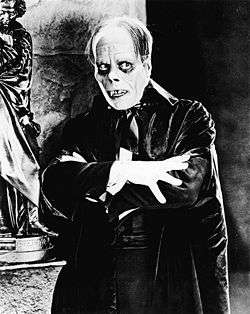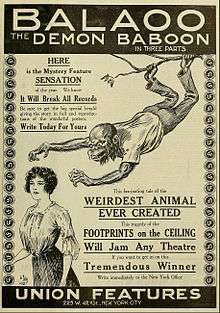Gaston Leroux
| Gaston Leroux | |
|---|---|
 Leroux in 1907 | |
| Born |
Gaston Louis Alfred Leroux 6 May 1868 Paris, France |
| Died |
15 April 1927 (aged 58) Nice, France |
| Occupation | Journalist, author |
| Nationality | French |
| Notable works | The Phantom of the Opera |
Gaston Louis Alfred Leroux (6 May 1868[1] – 15 April 1927) was a French journalist and author of detective fiction.
In the English-speaking world, he is best known for writing the novel The Phantom of the Opera (Le Fantôme de l'Opéra, 1910), which has been made into several film and stage productions of the same name, notably the 1925 film starring Lon Chaney, and Andrew Lloyd Webber's 1986 musical. His novel The Mystery of the Yellow Room is also one of the most famous locked-room mysteries ever.
Life and career
Leroux was born in Paris in 1868 and died in 1927 in Nice. He went to school in Normandy and studied law in Paris, graduating in 1889. He inherited millions of francs and lived wildly until he nearly reached bankruptcy. In 1890, he began working as a court reporter and theater critic for L'Écho de Paris. His most important journalism came when he began working as an international correspondent for the Paris newspaper Le Matin. He was present at, and covered, the 1905 Russian Revolution.
Another case at which he was present involved the investigation and in-depth coverage of the former Paris Opera (presently housing the Paris Ballet).[1] The basement contained a cell that held prisoners of the Paris Commune.
He suddenly left journalism in 1907 and began writing fiction. In 1919, he and Arthur Bernède formed their own film company, Société des Cinéromans, to publish novels and simultaneously turn them into films. He first wrote a mystery novel titled Le mystère de la chambre jaune (1908; The Mystery of the Yellow Room), starring the amateur detective Joseph Rouletabille. Leroux's contribution to French detective fiction is considered a parallel to Sir Arthur Conan Doyle's in the United Kingdom and Edgar Allan Poe's in the United States.
Leroux published his most famous work, The Phantom of the Opera, as a serial in 1909 and 1910, and as a book in 1910 (with an English translation appearing in 1911).
Leroux was made a Chevalier de la Legion d'honneur in 1909.
Novels
The Adventures of Rouletabille
- 1907 - Le mystère de la chambre jaune (English translation: The Mystery of the Yellow Room, 1907; Rouletabille and The Mystery of the Yellow Room, 2009, translated by Jean-Marc Lofficier & Randy Lofficier, ISBN 978-1-934543-60-3)
- 1908 - Le parfum de la dame en noir (English translation: The Perfume of the Lady in Black, 1908)
- 1913 - Rouletabille chez le Tsar (Rouletabille and the Tsar; English translation: The Secret of the Night, 1914)
- 1914 - Rouletabille à la guerre (Rouletabille at War) consisting of
- Le château noir (The Black Castle)
- Les étranges noces de Rouletabille (The Strange Wedding of Rouletabille;)
- 1917 - Rouletabille chez Krupp (English translation: Rouletabille at Krupp's, 2013, by Brian Stableford, ISBN 978-1-61227-144-6)
- 1921 - Le crime de Rouletabille (The Crime of Rouletabille; English translation: The Slave Bangle, 1925; The Phantom Clue, 1926, translated by Hannaford Bennett)
- 1922 - Rouletabille chez les Bohémiens (Rouletabille and the Gypsies; English translation: The Sleuth Hound [UK], 1926; The Octopus of Paris [US], 1927, translated by Hannaford Bennett)
Chéri Bibi
- Première Aventures de Chéri-Bibi (1913, English translations: The Floating Prison [UK] and Wolves of the Sea [US], 1923)
- Chéri-Bibi et Cécily (1916, English translations: Missing Men: The Return of Cheri-Bibi [US], Cheri-Bibi and Cecily [UK], 1923, translated by Hannaford Bennett)
- Nouvelles Aventures de Chéri-Bibi (1921, English translations: Part I - The Dark Road, 1924; Part II - The Dancing Girl [UK], Nomads of the Night [US], 1925)
- Le Coup d'État de Chéri-Bibi (1926, English translation: The New Idol, 1928)
Other novels


- La double vie de Théophraste Longuet (1903, English translations: The Double Life, 1909, translated by John E. Kearney; The Man with the Black Feather, 1912, translated by Edgar Jepson)
- Le roi mystère (1908)
- Le fauteuil hanté (1909, English translation: The Haunted Chair, 1931)
- Un homme dans la nuit (1910)
- La reine de Sabbat (1910, English translations: Part I as The Midnight Lady [UK], 1930; Part II as The Missing Archduke [UK], 1931)
- Le fantôme de l'Opéra (1910, English translation: The Phantom of the Opera, 1911)
- Balaoo (1911, English translation: Balaoo, 1913)
- L' épouse du soleil (1912, English translation: The Bride of the Sun, 1915)
- La colonne infernale (1916)
- Confitou (1916)
- L' homme qui revient de loin (1916, English translation: The Man who Came Back from the Dead, 1916)
- Le capitaine Hyx (1917, English translation: The Amazing Adventures of Carolus Herbert, 1922, translated by Hannaford Bennett)
- La bataille invisible (1917, English translation: The Veiled Prisoner [UK], 1923, translated by Hannaford Bennett)
- Tue-la-mort (1920, English translation: The Masked Man, 1929)
- Le coeur cambriolé (1920, English translation: The Burgled Heart, 1925; The New Terror, 1926)
- Le sept de trèfle (1921)
- La poupée sanglante (1923, English translations: The Kiss That Killed, 1934)
- La machine à assassiner (1923, English translation: The Machine to Kill, 1934)
- Les ténébreuses: La fin d'un monde & du sang sur la Néva (1924)
- Hardis-Gras ou le fils des trois pères (1924, English translation: The Son of 3 Fathers, 1927)
- La Farouche Aventure (serialized in "Le Journal" as La Coquette punie, 1924; English translation: The Adventures of a Coquette, 1926)
- La Mansarde en or (1925)
- Les Mohicans de Babel (1926)
- Mister Flow (1927, English translations: Part I as The Man of a Hundred Faces [USA] and The Queen of Crime [UK], 1930; Part II as Lady Helena, or The Mysterious Lady [USA], 1931)
- Les Chasseurs de danses (1927)
- Pouloulou (1990, posthumous)
Short stories

- 1887 - "Le petit marchand de pommes de terre frites"
- 1902 - "Les trois souhaits"
- 1907 - "Baïouchki baïou"
- 1908 - "L'homme qui a vu le diable" (English translation: "In Letters of Fire", 1908)
- 1911 - "Le dîner des bustes" (English translation: "A Terrible Tale", 1925)
- 1912 - "La hache d'or" (English translation: "The Gold Axe", 1925)
- 1924 - "Le Noël du petit Vincent-Vincent" (English translation: "The Crime on Christmas Night", 1930)
- 1924 - "La femme au collier de velours" (English translation: "The Woman with the Velvet Collar", 1929)
- 1924 - "Not'olympe" (English translation: "The Mystery of the Four Husbands", 1929)
Plays
- 1908 - Le Lys (co-author: Pierre Wolff)
- 1913 - Alsace (co-author: Lucien Camille)
Filmography
- Balaoo, directed by Victorin-Hippolyte Jasset (1913, short film, based on the novel Balaoo)
- Chéri-Bibi, directed by Charles Krauss (1914, short film, based on the novel Chéri-Bibi)
- Alsace, directed by Henri Pouctal (1916, based on the play Alsace)
- L'Homme qui revient de loin, directed by Gaston Ravel (1917, based on the novel L'Homme qui revient de loin)
- La Nouvelle aurore, directed by Édouard-Émile Violet (1919, serial with 16 episodes, based on the novel Nouvelles aventures de Chéri-Bibi)
- A halál után, directed by Alfréd Deésy (Hungary, 1920, based on the novel L'Homme qui revient de loin)
- The Lily, directed by Victor Schertzinger (1926, based on the play Le Lys)
- The Wizard, directed by Richard Rosson (1927, based on the novel Balaoo)
- The Phantom of Paris, directed by John S. Robertson (1931, based on the novel Chéri-Bibi et Cécily)
- Cheri-Bibi, directed by Carlos F. Borcosque (1931), alternative Spanish-language version of The Phantom of Paris
- Compliments of Mister Flow, directed by Robert Siodmak (1936, based on the novel Mister Flow)
- Chéri-Bibi, directed by Léon Mathot (1938, based on the novel Chéri-Bibi)
- Dr. Renault's Secret, directed by Harry Lachman (1942, based on the novel Balaoo), uncredited
- The Man Who Returns from Afar, directed by Jean Castanier (1950, based on the novel L'Homme qui revient de loin)
- Chéri-Bibi, directed by Marcello Pagliero (1955, based on the novel Chéri-Bibi)
- La Poupée sanglante, directed by Marcel Cravenne (1976, miniseries, based on the novel La poupée sanglante and its sequel, La machine à assassiner)
Screenwriter
- Tue la mort, directed by René Navarre (1920, serial with 12 episodes)
- Le Sept de trèfle, directed by René Navarre (1921, serial with 12 episodes)
- Il était deux petits enfants, directed by Lino Manzoni (1922)
References
- 1 2 "Gaston Leroux - Biography and Works. Search Texts, Read Online. Discuss". www.online-literature.com. Retrieved 2016-09-18.
External links
| Wikisource has original works written by or about: Gaston Leroux |
| Wikimedia Commons has media related to Gaston Leroux. |
- Works by Gaston Leroux at Project Gutenberg
- Works by or about Gaston Leroux at Internet Archive
- Works by Gaston Leroux at LibriVox (public domain audiobooks)

- About Gaston Leroux, gaston-leroux.net
- Books and Biography of Leroux, Gaston, readprint.com
- (in French) L'univers de Joseph Rouletabille, rouletabille.perso.cegetel.net
- Everything about Phantom legend and his creator, Gaston Leroux, ladyghost.com
- Gaston Leroux at Find a Grave
- (in French) Gaston Leroux, his work in audio version, litteratureaudio.com
